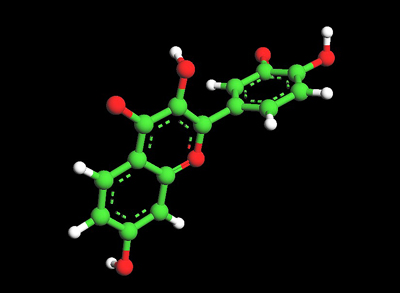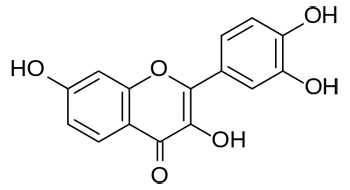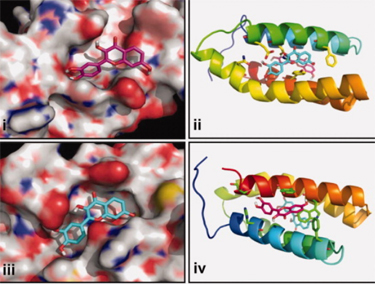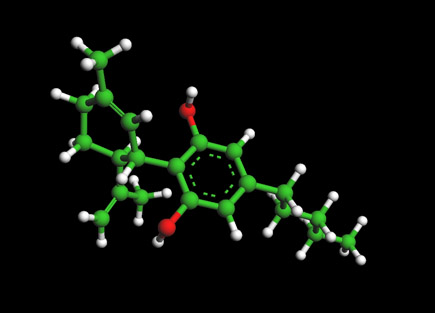Fisetin as a Senolytic and Anti-Aging Molecule
Recent study shows that of the 10 flavonoids tested, fisetin was the most potent senolytic. .... studies demonstrate that senolytic compounds can have significant effects on on chronic degenerative diseases and age-related pathology... see below--

Ball and Stick Model for Fisetin A Molecule
Fisetin Molecule (above) Ball-and-stick. For 3D Jsmol File
Molecular formula C15H10O6
Molar mass 286.2363 g/mol
Fisetin Molecular Structure

Overview of Fisetin
Fisetin (3,3′,4′,7-tetrahydroxyflavone, above) is a polyphenol which is a bioactive flavonol molecule found in fruits and vegetables such as strawberry, apple, persimmon, grape, onion, and cucumber at concentrations in the range of 2–160 μg/g.
Fisetin, like other polyphenols such as resveratrol, is a sirtuin-activating compound and has been shown in laboratory studies to extend the life of simple organisms like yeast, worms, and flies. see: A Molecular Mechanism for Direct Sirtuin Activation by Resveratrol .
In lab studies it also has been shown to be an anti-proliferative agent, interfering with the cell cycle in several ways.--
--Downregulation of tumor necrosis factor and other proinflammatory biomarkers by polyphenols
--The Natural Flavonoid Fisetin Inhibits Cellular Proliferation of Hepatic, Colorectal, and Pancreatic Cancer Cells through Modulation of Multiple Signaling PathwaysFisetin, like some other flavonoids, has been found in lab studies to be a topoisomerase inhibitor, which may turn out to be a carcinogenic activity or an anti-cancer activity - further research is needed. The dietary flavonoids myricetin and fisetin act as dual inhibitors of DNA topoisomerases I and II in cells.
Fistein has been shown to be an effective senolytic agent in wild-type mice, with effects of increased lifespan, reduced senescence markers in tissues, and reduced age-related pathologies. A clinical trial in the U.S. is currently underway as of October 2018 to show effectiveness in humans. (Clinical Trials.gov -- Alleviation by Fisetin of Frailty, Inflammation, and Related Measures in Older Women (AFFIRM) ).
In studies conducted on cells in a laboratory, fisetin inhibits the activity of several pro-inflammatory cytokines, including tumor necrosis factor alpha, interleukin 6, and Nuclear factor kappa B. It has also been shown in lab studies to upregulate glutathione, an endogenous antioxidant. Fisetin Boosts Cellular Glutathione .
Fisetin suppressed PI3K/Akt and mTOR signaling
Novel inhibitors of PI3-K, Akt, and mTOR are now passing through early phase clinical trials. This review article looks at the effect of fisetin on the PI3-K/Akt/mTOR pathway as studied in different cancer cell models...." See: Inhibition of Akt/mTOR Signaling by the Dietary Flavonoid Fisetin
Below dock model showing fisetin binding to mTOR protein.

"...Hypothetical model of the mTOR molecule in complex with fisetin. (i and iii) Blind docking of fisetin to the mTOR target was performed with autodock 4 by setting grid sizes that included the entire mTOR molecule. The structure consists of four stacked alpha helices. The grid size for the docking site was expanded to include the entire mTOR molecule and fisetin was docked. Using autodock 4, fisetin bound to two sites on the mTOR target..." From Dual inhibition of phosphatidylinositol 3‐kinase/Akt and mammalian target of rapamycin signaling in human nonsmall cell lung cancer cells by a dietary flavonoid fisetin
Fisetin has shown anti-cancer activity in studies on cells and model animals conducted in laboratories, and appears to block the PI3K/AKT/mTOR pathway. See: Dietary flavonoid fisetin: A novel dual inhibitor of PI3K/Akt and mTOR for prostate cancer management.
Abstracts:
Fisetin is a senotherapeutic that extends health and lifespan
Background --Senescence is a tumor suppressor mechanism activated in stressed cells to prevent replication of damaged DNA. Senescent cells have been demonstrated to play a causal role in driving aging and age-related diseases using genetic and pharmacologic approaches. We previously demonstrated that the combination of dasatinib and the flavonoid quercetin is a potent senolytic improving numerous age-related conditions including frailty, osteoporosis and cardiovascular disease. The goal of this study was to identify flavonoids with more potent senolytic activity.
"... the 10 flavonoids tested, fisetin was the most potent senolytic. Acute or intermittent treatment of progeroid and old mice with fisetin reduced senescence markers in multiple tissues, consistent with a hit-and-run senolytic mechanism. Fisetin reduced senescence in a subset of cells in murine and human adipose tissue, demonstrating cell-type specificity. Administration of fisetin to wild-type mice late in life restored tissue homeostasis, reduced age-related pathology, and extended median and maximum lifespan.
Interpretation The natural product fisetin has senotherapeutic activity in mice and in human tissues. Late life intervention was sufficient to yield a potent health benefit. These characteristics suggest the feasibility to translation to human clinical studies..." -
--Of the 10 flavonoids tested, fisetin was the most potent senolytic.
- Source
Clinical Trials
October 2018 --Alleviation by Fisetin of Frailty, Inflammation, and Related Measures in Older Women -70-90 yrs Old (AFFIRM)
Dietary Fisetin -- Experimental: Treatment Fisetin 20/mg/kg/day, orally for 2 consecutive days, for 2 consecutive months vs placebo.
Start Date -February 6, 2018--- Completion Date - June 30, 2020
Anti-Aging and Senolytics Home Page
- What is Anti-Aging Medicine
- What is Senescence?
- What are Senolytics?
- About Caloric Restriction
- Mtor and Rapamycin
- The IKK/NF-κB signaling pathway in aging
- Exercise and Anti-Aging
- Meditation and Anti-Aging
SENOLYTIC AND ANTI-AGING MOLECULES
RAPAMYCIN ---The mechanistic target of rapamycin (mTOR) pathway has a central role in cell activation...
METFORMIN -- The diabetes drug metformin used by some for anti-aging may diminish benefits of aerobic exercise...
QUERCETIN-- AND WITH DASATINIB--The senolytic cocktail, dasatinib plus quercetin, which causes selective elimination of senescent cells...
FISETIN--Of the 10 flavonoids tested, fisetin was the most potent senolytic...
EGCG- The most active component of green tea....
NAD BOOSTERS --'...The cells of the old mice were indistinguishable from the young mice, after just one week of treatment...
SULFORAPHANE-- An isothiocyanate present in cruciferous vegetables activates antioxidant and anti-inflammatory responses by ...
UROLITHIN --Metabolite of Pomegranate compound with anti-aging effects passes human trial...
MITO-Q -- A water soluble fomr of CoQ10 that has excellent absorption and high bioavailability...
HONOKIOL - A bioactive natural product derived from Magnolia Bark have demonstrated ...
CURCUMIN AND ANALOGS -Recent research is focused on the design and synthesis of curcumin analogs as antiproliferative and anti-inflammatory agents...
BERBERINE --berberine has recently been reported to expand life span in Drosophila melanogaster, and attenuate premature cellular senescence
N-ACETYL-CYSTINE (NAC)--"...pretreatment with NAC increased glutathione levels in the older cells and largely helped offset that level of cell death..."
PIPERLONGUMINE - A natural product from the Long pepper with high bioavailability...
RESVERATROL AND PTEROTSILBINE -- Pterostilben chemically similar to resveratrol bute differs from resveratrol by exhibiting increased bioavailability (80% compared to 20% in resveratrol)
SPERMIDINE--Spermidine delays aging in humans ...
ALLICIN -- Allicin is a compound produced when garlic is crushed or chopped. ...
VITAMIN D3 -- Production of the active forms of Vitamin D are reduced by 50% as a result of an age-related decline
VITAMIN K-- evidence suggests vitamin K has an anti-inflammatory action
TOCOTRIENOL(AND WITH QUERCETIN) --Tocotrieniols have been found to exert a synergistic antitumor effect on cancer cells when given in combination....
HSP-90 INHIBITORS --As a novel class of senolytics
The Cannabidiol Molecule
Cannabidiol (CBD is the major non-psychoactive component of Cannabis and is being looked at by major drug and consumer companies for various medical and social uses.